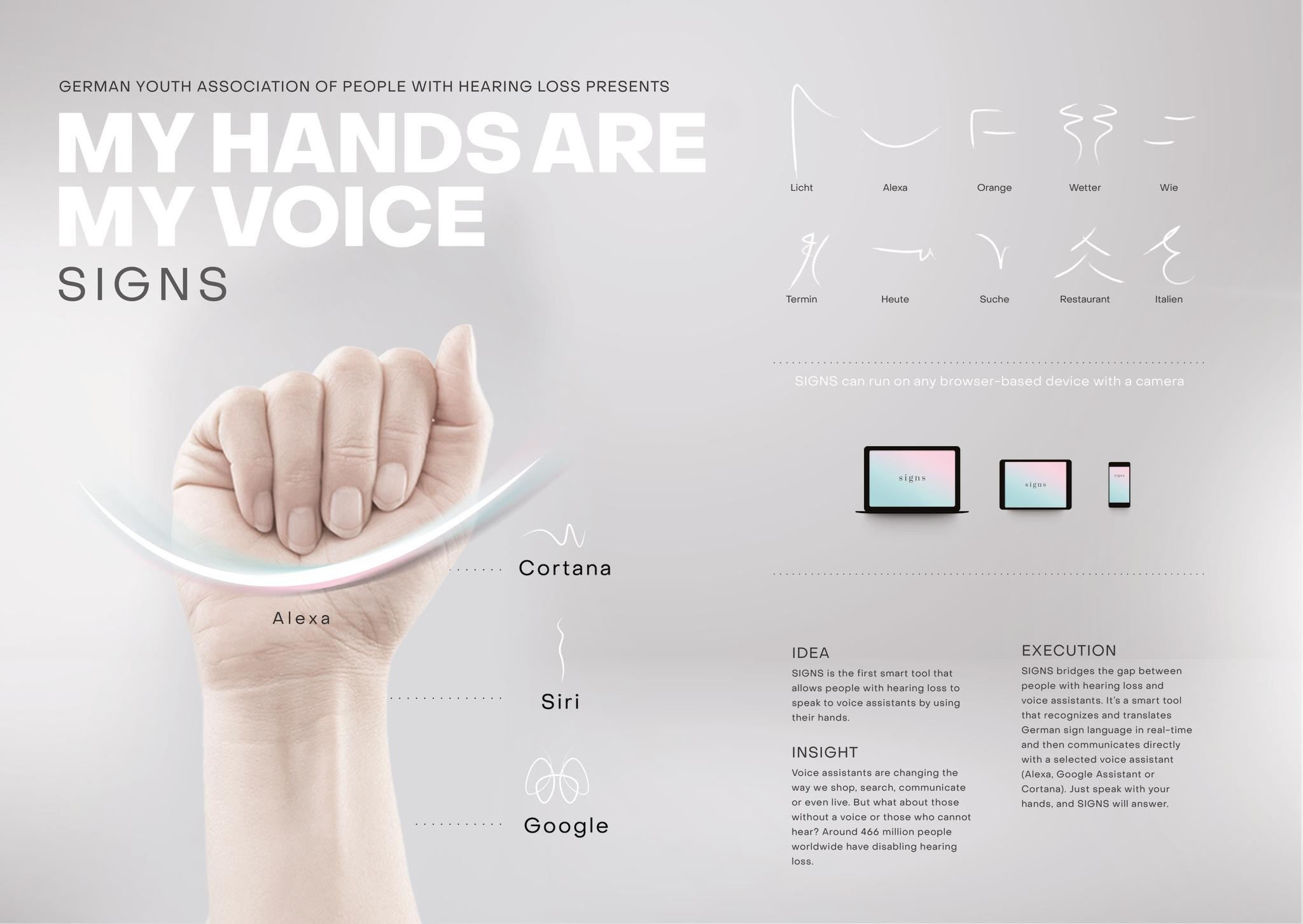Cannes Lions
Signs
MRM//McCANN, Frankfurt / GERMAN YOUTH ASSOCIATION OF PEOPLE WITH HEARING LOSS / 2019

Overview
Entries
Credits
Overview
Background
There are over 2 billion voice-enabled devices across the globe. Voice assistants are changing the way we shop, search, communicate or even live. At least for most people. But what about those without a voice? What about those who cannot hear? According to the World Health Organization around 466 million people worldwide have disabling hearing loss. Project SIGNS was developed to create awareness for inclusion in the digital age as well as to facilitate access to new technologies.
Idea
Voice assistants are changing the way we shop, search, communicate or even live. At least for most people. But what about those without a voice? What about those who cannot hear? Around 466 million people worldwide have disabling hearing loss. With the SIGNS Project, we are creating awareness for digital accessibility and inclusion. SIGNS is the first smart voice assistant solution for people with hearing loss worldwide. It’s an innovative smart tool that recognizes and translates sign language in real-time and then communicates directly with a selected voice assistant service (e.g. Amazon Alexa, Google Assistant or Microsoft Cortana). SIGNS is reinventing voice – one gesture at a time. Many people with hearing loss use their hands to speak. And that’s all they need to talk to SIGNS. How's the weather tomorrow? Change lights to blue. Find an Italian restaurant. Just speak, and SIGNS will answer.
Strategy
SIGNS was pre-trained with video footage of people who use sign language. SIGNS includes a training interface that can be used to teach new gestures in real time.
SIGNS then recognizes these gestures and acts as an interface to voice assistant systems such as Amazon Alexa, Google Home or Microsoft Cortana. SIGNS is based on an intelligent machine learning framework that is trained to identify body gestures with the help of an integrated camera. These gestures are converted into a data format that the voice assistant service understands. The voice assistant processes the data in real-time and replies appropriately. SIGNS replaces voice assistants’ typical form of communication through audio signals with a visuality – but not only by displaying the word. The visual interface of SIGNS fulfills various requirements that are necessary for an intuitive experience. SIGNS follows the basic principles of sign language. Therefore, the SIGNS dictionary was developed – a set of symbols that are inspired by the hand movements. Just like with other voice assistant devices the user has to naturally interact with the device.
Execution
Many people with hearing loss use their hands to speak. This is their natural language. Their hands are their voice. However, voice assistants use natural language processing to decipher and react only to audible commands. No sound means no reaction. SIGNS bridges the gap between deaf people and voice assistants, by recognizing gestures to communicate directly with existing voice assistant services (e.g. Amazon Alexa, Google Home or Microsoft Cortana). SIGNS is based on an intelligent machine learning framework (Google TensorFlow) that is trained to identify body gestures with the help of an integrated camera. These gestures are converted into a data format that the selected voice assistant service understands. How's the weather tomorrow? Change lights to blue. Find an Italian restaurant. Just speak, and SIGNS will answer. SIGNS is a smart tool that works on any browser-based operating system that has an integrated camera (laptops, tablets, smartphones). SIGNS can easily be connected to voice assistant services such as Alexa, Google Assistant or Cortana. Further we started a cooperation with the German Youth Association of People with Hearing Loss as a partner and extended the usability. Never before a sign language assistant was launched in that quality and with the prospect of becoming a worldwide platform, that can easily be accessible from all over the world, learning new signs and sign languages.
Outcome
Project SIGNS created awareness for inclusion in the digital age as well as facilitated access to new technologies. The response of the deaf community was overwhelming. Just like voice, gestures are an intuitive way of communicating, making it extremely relevant for the industry. Not just for the hearing impaired, but for everyone. People think it is awkward to speak to the invisible in public, that’s why we believe that invisible conversational interactions with the digital world are not limited to voice itself. Further we started a cooperation with the German Youth Association of People with Hearing Loss as a partner and extended the usability. Never before a sign language assistant was launched in that quality and with the prospect of becoming a worldwide platform, that can easily be accessible from all over the world, learning new signs and sign languages.
